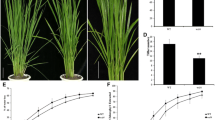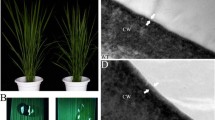Abstract
Epidermal cell layers play important roles in plant defenses against various environmental stresses. Here we report the identification of a cuticle membrane mutant, wilted dwarf and lethal 1 (wdl1), from a rice T-DNA insertional population. The muant is dwarf and die at seedling stage due to increased rates of water loss. Stomatal cells and pavement cells are smaller in the mutant, suggesting that WDL1 affects epidermal cell differentiation. T-DNA was inserted into a gene that encodes a protein belonging to the SGNH subfamily, within the GDSL lipase superfamily. The WDL1–sGFP signal coincided with the RFP signal driven by AtBIP–mRFP, indicating that WDL1 is an ER protein. SEM analyses showed that their leaves have a disorganized crystal wax layer. Cross-sectioning reveals loose packing of the cuticle and irregular thickness of cell wall. Detailed analyses of the epicuticular wax showed no significant changes either in the total amount and amounts of each monomer or in the levels of lipid polymers, including cutin and other covalently bound lipids, attached to the cell wall. We propose that WDL1 is involved in cutin organization, affecting depolymerizable components.









Similar content being viewed by others
References
Aharoni A, Dixit S, Jetter R et al (2004) The SHINE clade of AP2 domain transcription factors activates wax biosynthesis, alters cuticle properties, and confers drought tolerance when overexpressed in Arabidopsis. Plant Cell 16:2463–2480
Akoh CC, Lee GC, Liaw YC et al (2004) GDSL family of serine esterases/lipases. Prog Lipid Res 43:534–552
An S, Park S, Jeong DH et al (2003) Generation and analysis of end sequence database for T-DNA tagging lines in rice. Plant Physiol 133:2040–2047
An G, Jeong DH, Jung KH, Lee S (2005a) Reverse genetic approaches for functional genomics of rice. Plant Mol Biol 59:111–123
An G, Lee S, Kim SH, Kim SR (2005b) Molecular genetics using T-DNA in rice. Plant Cell Physiol 46:14–22
Ao CQ (2006) Morphological characters of leaf epidermis in Schisandraceae and their systematic significance. J Plant Biol 49:80–87
Avato P (1987) Chemical genetics of epicuticular wax formation in maize. Plant Physiol Biochem 25:179–190
Baker EA (1982) Chemistry and morphology of plant epicuticular waxes. In: Cutler DF, Alvin KL, Price CE (eds) The plant cuticle. Academic Press, London, pp 139–165
Beattie GA, Marcell L (2002) Effect of alterations in cuticular wax biosynthesis on the physiochemical properties and topography of maize leaf surfaces. Plant Cell Environ 25:1–16
Bonaventure G, Beisson F, Ohlrogge J, Pollard M (2004) Analysis of the aliphatic monomer composition of polyesters associated with Arabidopsis epidermis: occurrence of octadeca-cis-6, cis-9-diene-1, 18-dioate as the major component. Plant J 40:920–930
Carver TLW, Gurr SJ (2006) Filamentous fungi on plant surfaces. In: Biology of the plant cuticle. pp 368–397
Chen X, Goodwin SM, Boroff VL et al (2003) Cloning and characterization of the WAX2 gene of Arabidopsis involved in cuticle membrane and wax production. Plant Cell 15:1170–1185
Chen G, Sagi M, Weining S et al (2004) Wild barley eibi1 mutation identifies a gene essential for leaf water conservation. Planta 219:684–693
Clauβ K, Baumert A, Nimtz M et al (2008) Role of a GDSL lipase-like protein as sinapine esterase in Brassicaceae. Plant J 53:802–813
Franke R, Briesen I, Wojciechowski T et al (2005) Apoplastic polyesters in Arabidopsis surface tissues–a typical suberin and a particular cutin. Phytochem 66:2643–2658
Gray JE, Holroyd GH, van der Lee FM et al (2000) The HIC signalling pathway links CO2 perception to stomatal development. Nature 408:713–716
Gulz PG (1994) Epicuticular leaf waxes in the evolution of the plant kingdom. Plant Physiol 143:453–464
Haas K, Brune T, Rücker E (2001) Epicuticular wax crystalloids in rice and sugar cane leaves are reinforced by polymeric aldehydes. J Appl Bot 75:178–187
Hansen JD, Pyee J, Xia Y et al (1997) The glossy1 locus of maize and an epidermis-specific cDNA from Kleinia odora define a class of receptor-like proteins required for the normal accumulation of cuticular waxes. Plant Physiol 113:1091–1100
Iuchi S, Yamaguchi-Shinozaki K, Urao T et al (1996) Novel drought-inducible genes in the highly drought-tolerant cowpea: cloning of cDNAs and analysis of the expression of the corresponding genes. Plant Cell Physiol 37:1073–1082
Jeffree CE (1996) Structure and ontogeny of plant cuticles. In: Kerstiens G (ed) Plant cuticles. BIOS Scientific Publishers, Oxford, pp 33–82
Jenks MA, Joly RJ, Peters PJ et al (1994) Chemically induced cuticle mutation affecting epidermal conductance to water vapor and disease susceptibility in Sorghum bicolor (L.) Moench. Plant Physiol 105:1239–1245
Jenks MA, Rashotte AM, Tuttle HA, Feldmann KA (1996) Mutants in Arabidopsis thaliana altered in epicuticular wax and leaf morphology. Plant Physiol 110:377–385
Jeon JS, Lee S, Jung KH et al (2000) T-DNA insertional mutagenesis for functional genomics in rice. Plant J 22:561–570
Jeong DH, An S, Kang HG et al (2002) T-DNA insertional mutagenesis for activation tagging in rice. Plant Physiol 130:1636–1644
Jeong DH, An S, Park S et al (2006) Generation of flanking sequence-tag database for activation-tagging lines in japonica rice. Plant J 45:123–132
Jetter R, Riederer RM (1994) Epicuticular crystals of nonacosan-10-ol: in vitro reconstitution and factors influencing crystal habits. Planta 195:257–270
Jung KH, Han MJ, Lee DY et al (2006) Wax-deficient anther1 is involved in cuticle and wax production in rice anther walls and is required for pollen development. Plant Cell 18:3015–3032
Kerstiens G (2006) Water transport in plant cuticles: an update. J Exp Bot 57:2493–2499
Kerstiens G, Schreiber L, Lendzian KJ (2006) Quantification of cuticular permeability in genetically modified plants. J Exp Bot 57:2547–2552
Kirsch T, Kaffarnik F, Riederer M, Schreiber L (1997) Cuticular permeability of the three tree species Prunus iaurocerasus L., Ginkgo biloba L. and Juglans regia L: comparative investigation of the transport properties of intact leaves, isolated cuticles and reconstituted cuticular waxes. J Exp Bot 48:1035–1045
Koizumi K, Ookawa T, Satoh H, Hirasawa T (2007) A wilty mutant of rice has impaired hydraulic conductance. Plant Cell Physiol 48:1219–1228
Kolattukudy PE (2001) Polyesters in higher plants. In: Scheper T (ed) Advances in biochemical engineering/biotechnology, vol 71. Springer, Berlin, pp 1–49
Kunst L, Samuels AL (2003) Biosynthesis and secretion of plant cuticular wax. Progr Lipid Res 42:51–80
Kurdyukov S, Faust A, Nawrath C et al (2006) The epidermis-specific extracellular BODYGUARD controls cuticle development and morphogenesis in Arabidopsis. Plant Cell 18:321–339
Lee S, Kim J, Son JS, Nam J et al (2003) Systematic reverse genetic screening of T-DNA tagged genes in rice for functional genomic analyses: MADS-box genes as a test case. Plant Cell Physiol 44:1403–1411
Lee MO, Choi PG, Kim JA et al (2006) Two novel protein kinase genes, OsMSRPK1 and OsMSURPK2, are regulated by diverse environmental stresses in rice. J Plant Biol 49:247–256
Lemieux B (1996) Molecular genetics of epicuticular waxes biosynthesis. Trends Plant Sci 1:312–318
Leveau JH (2006) Microbial communities in the phyllosphere. In: Riederer M, Müller C (eds) In: Annual plant reviews: biology of the plant cuticle 23. Blackwell, Oxford, pp 334–367
Ling H, Zhao J, Zuo K et al (2006) Isolation and expression analysis of a GDSL-like lipase gene from Brassica napus L. J Biochem Mol Biol 39:297–303
Lolle SJ, Berlyn GP, Engstrom EM et al (1997) Developmental regulation of cell interactions in the Arabidopsis fiddlehead-1 mutant: a role for the epidermal cell wall and cuticle. Dev Biol 189:311–321
Moon S, Giglione C, Lee DY et al (2008) Rice peptide deformylase PDF1B is crucial for development of chloroplasts. Plant Cell Physiol 49:1536–1546
Park M, Kim SJ, Vitale A, Hwang I (2004) Identification of the protein storage vacuole and protein targeting to the vacuole in leaf cells of three plant species. Plant Physiol 134:625–639
Pfündel EE, Agati G, Cerovic ZG (2006) Optical properties of plant surfaces. In: Riederer M, Müller C (eds) Annual plant reviews 23: biology of the plant cuticle. Blackwell, Oxford, pp 216–249
Rabbani MA, Maruyama K, Abe H et al (2003) Monitoring expression profiles of rice genes under cold, drought, and high-salinity stresses and abscisic acid application using cDNA microarray and RNA gel-blot analyses. Plant Physiol 133:1755–1767
Riederer M, Schreiber L (2001) Protecting against water loss: analysis of the barrier properties of plant cuticles. J Exp Bot 52:2023–2032
Rowland O, Zheng H, Hepworth SR et al (2006) CER4 encodes an alcohol-forming fatty acyl-coenzyme A reductase involved in cuticular wax production in Arabidopsis. Plant Physiol 142:866–877
Rowland O, Lee R, Franke R et al (2007) The CER3 wax biosynthetic gene from Arabidopsis thaliana is allelic to WAX2/YRE/FLP1. FEBS Lett 581:3538–3544
Ryu CH, You JH, Kang HG et al (2004) Generation of T-DNA gene tagging lines with a bidirectional gene trap vector and the establishment of an insertion-site database. Plant Mol Biol 54:489–502
Sánchez E, Montiel M, Espinoza AM (2003) Ultrastructural morphologic description of the wild rice species Oryza latifolia (Poaceae) in Costa Rica. Rev Biol Trop 51:345–353
Schnurr J, Shockey J, Browse J (2004) The acyl-CoA synthetase encoded by LACS2 is essential for normal cuticle development in Arabidopsis. Plant Cell 16:629–642
Schreiber L (2005) Polar paths of diffusion across plant cuticles: new evidence for an old hypothesis. Ann Bot (Lond) 95:1069–1073
Shepherd T, Wynne Griffiths D (2006) The effects of stress on plant cuticular waxes. New Phytol 171:469–499
Stimler K, Xing B, Chefetz B (2006) Transformation of plant cuticles in soil: effect on their sorptive capabilities. Soil Sci Soc Am J 70:1101–1109
Sturaro M, Hartings H, Schmelzer E et al (2005) Cloning and characterization of GLOSSY1, a maize gene involved in cuticle membrane and wax production. Plant Physiol 138:478–489
Wellesen K, Durst F, Pinot F et al (2001) Functional analysis of the LACERATA gene of Arabidopsis provides evidence for different roles of fatty acid omega-hydroxylation in development. Proc Natl Acad Sci USA 98:9694–9699
Woo YM, Park HJ, Su’udi M et al (2007) Constitutively wilted 1, a member of the rice YUCCA gene family, is required for maintaining water homeostasis and an appropriate root to shoot ratio. Plant Mol Biol 65:125–136
Xiao F, Goodwin SM, Xiao Y et al (2004) Arabidopsis CYP86A2 represses Pseudomonas syringae type III genes and is required for cuticle development. EMBO J 23:2903–2913
Xu X, Dietrich CR, Delledonne M et al (1997) Sequence analysis of the cloned glossy8 gene of maize suggests that it may code for a beta-ketoacyl reductase required for the biosynthesis of cuticular waxes. Plant Physiol 115:501–510
Yoshida R, Hobo T, Ichimura K et al (2002) ABA-activated SnRK2 protein kinase is required for dehydration stress signaling in Arabidopsis. Plant Cell Physiol 43:1473–1483
Yu D, Ranathunge K, Huang H et al (2008) Wax Crystal-Sparse Leaf1 encodes a beta-ketoacyl CoA synthase involved in biosynthesis of cuticular waxes on rice leaf. Planta 228:675–685
Acknowledgements
We thank Insoon Park and Kyungsook An for generating T-DNA insertional lines, Yoonja Cho for handling the seed stock, Yong Mok Park for providing the steady state porometer, Inhwan Hwang for the vector containing the AtBIP: mRFP fusion, and Priscilla Licht for English editing. This work was supported, in part, by grants from the Crop Functional Genomic Center, the 21st Century Frontier Program (Grant CG1111); from the Biogreen 21 Program (034-001-007-03-00), Rural Development Administration; and from the Basic Research Promotion Fund with a Korea Research Foundation Grant (KRF-2007-341-C00028); Technology Development Program for Agriculture and Forestry, Ministry for Food, Agriculture, Forestry and Fisheries, Republic of Korea (309,017-5); and Kyung Hee University to GA, and grants of the Deutsche Forschungsgemeinschaft (DFG) to LS and RF.
Author information
Authors and Affiliations
Corresponding author
Electronic supplementary material
Below is the link to the electronic supplementary material.
11103_2010_9656_MOESM1_ESM.tif
Supplementary Fig. 1 Phylogenic tree of WDL1. Sequences were aligned via Clustal X 1.81 and tree was constructed using neighbor-joining program in MEGA version 2.0. Scale bar corresponds to 0.1 amino substitutions per residue. (TIFF 301 kb)
Rights and permissions
About this article
Cite this article
Park, JJ., Jin, P., Yoon, J. et al. Mutation in Wilted Dwarf and Lethal 1 (WDL1) causes abnormal cuticle formation and rapid water loss in rice. Plant Mol Biol 74, 91–103 (2010). https://doi.org/10.1007/s11103-010-9656-x
Received:
Accepted:
Published:
Issue Date:
DOI: https://doi.org/10.1007/s11103-010-9656-x




